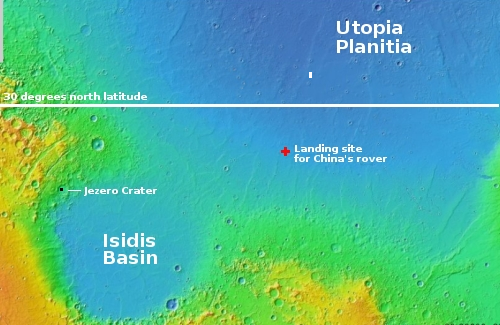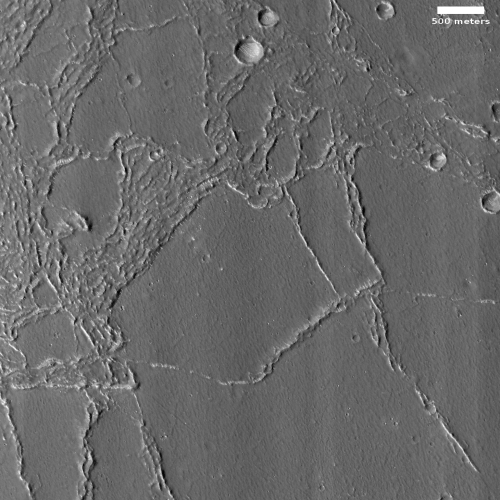Inexplicable ridges north of China’s Mars rover
Cool image time! The photo to the right, rotated, cropped, and reduced to post here, shows some unusual geology about 450 miles north of the approximate area where China’s Zhurong rover landed in the northern lowlands of Mars. It was taken on April 14, 2021 by the high resolution camera on Mars Reconnaissance Orbiter (MRO).
These scattered ridges remind me of wrinkle ridges, formed when the surface of a place shrinks. With less surface area, the extra material needs somewhere to go, and so ridges are forced up at weak points to release the pressure.
Assuming this hand-waving explanation is true, the next question would be: What causes the shrinking? The overview map below might help provide an answer.

The white rectangle marks the location of these ridges in Utopia Planitia. At 33 degrees north latitude this is a region where it is believed there is much underground ice, some of which should be relatively close to the surface. The shrinkage that caused these ridges could be from some freeze-sublimation cycle as that ice erodes away with the changing Martian climate.
Sounds good, eh? Hogwash. I am only guessing, based on very little information. For one thing, click on the first image above and take a look at the full image. As you move north the ridges begin to fill the space and become ubiquitous. How does my simple theory of wrinkle ridges explain that?
The image appears to be a terrain sample photo, one taken by the MRO science team not based on any specific scientists request but to maintain the camera’s temperature by taking regular images. When they do this they try to snap pictures of interesting things. They succeeded here.
Since no scientist requested this image it means no scientist is doing work to explain these features. Are you a student of planetary science looking for a research project? Here’s one, open for the taking.
On Christmas Eve 1968 three Americans became the first humans to visit another world. What they did to celebrate was unexpected and profound, and will be remembered throughout all human history. Genesis: the Story of Apollo 8, Robert Zimmerman's classic history of humanity's first journey to another world, tells that story, and it is now available as both an ebook and an audiobook, both with a foreword by Valerie Anders and a new introduction by Robert Zimmerman.
The print edition can be purchased at Amazon or from any other book seller. If you want an autographed copy the price is $60 for the hardback and $45 for the paperback, plus $8 shipping for each. Go here for purchasing details. The ebook is available everywhere for $5.99 (before discount) at amazon, or direct from my ebook publisher, ebookit. If you buy it from ebookit you don't support the big tech companies and the author gets a bigger cut much sooner.
The audiobook is also available at all these vendors, and is also free with a 30-day trial membership to Audible.
"Not simply about one mission, [Genesis] is also the history of America's quest for the moon... Zimmerman has done a masterful job of tying disparate events together into a solid account of one of America's greatest human triumphs."--San Antonio Express-News
Cool image time! The photo to the right, rotated, cropped, and reduced to post here, shows some unusual geology about 450 miles north of the approximate area where China’s Zhurong rover landed in the northern lowlands of Mars. It was taken on April 14, 2021 by the high resolution camera on Mars Reconnaissance Orbiter (MRO).
These scattered ridges remind me of wrinkle ridges, formed when the surface of a place shrinks. With less surface area, the extra material needs somewhere to go, and so ridges are forced up at weak points to release the pressure.
Assuming this hand-waving explanation is true, the next question would be: What causes the shrinking? The overview map below might help provide an answer.

The white rectangle marks the location of these ridges in Utopia Planitia. At 33 degrees north latitude this is a region where it is believed there is much underground ice, some of which should be relatively close to the surface. The shrinkage that caused these ridges could be from some freeze-sublimation cycle as that ice erodes away with the changing Martian climate.
Sounds good, eh? Hogwash. I am only guessing, based on very little information. For one thing, click on the first image above and take a look at the full image. As you move north the ridges begin to fill the space and become ubiquitous. How does my simple theory of wrinkle ridges explain that?
The image appears to be a terrain sample photo, one taken by the MRO science team not based on any specific scientists request but to maintain the camera’s temperature by taking regular images. When they do this they try to snap pictures of interesting things. They succeeded here.
Since no scientist requested this image it means no scientist is doing work to explain these features. Are you a student of planetary science looking for a research project? Here’s one, open for the taking.
On Christmas Eve 1968 three Americans became the first humans to visit another world. What they did to celebrate was unexpected and profound, and will be remembered throughout all human history. Genesis: the Story of Apollo 8, Robert Zimmerman's classic history of humanity's first journey to another world, tells that story, and it is now available as both an ebook and an audiobook, both with a foreword by Valerie Anders and a new introduction by Robert Zimmerman.
The print edition can be purchased at Amazon or from any other book seller. If you want an autographed copy the price is $60 for the hardback and $45 for the paperback, plus $8 shipping for each. Go here for purchasing details. The ebook is available everywhere for $5.99 (before discount) at amazon, or direct from my ebook publisher, ebookit. If you buy it from ebookit you don't support the big tech companies and the author gets a bigger cut much sooner.
The audiobook is also available at all these vendors, and is also free with a 30-day trial membership to Audible.
"Not simply about one mission, [Genesis] is also the history of America's quest for the moon... Zimmerman has done a masterful job of tying disparate events together into a solid account of one of America's greatest human triumphs."--San Antonio Express-News



Only a brief note. In the ‘southern’ (lower) part of the full image, the ‘fractures’ appear to have a preferred orientation. That’s a key to the structural context. Would need to see surrounding area, ideally in 3-D imagery, to take a shot at explaining these. Like thin ice on a lake, or ???